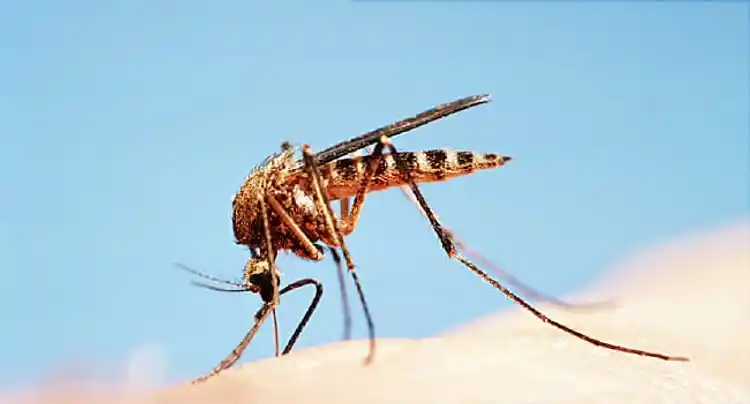July 17, 2023 — Illnesses spread by ticks and mosquitos are on the rise, prompting warnings from doctors and scientists to take precautions and watch out for any telltale symptoms.
At least seven cases of malaria from mosquitoes in the United States were reported in Florida and Texas last month – the first reports of local spread in 20 years. Cases of tick-borne illness, like Lyme disease, in the U.S. have increased 25%, from 40,795 reported cases in 2011 to 50,856 in 2019, according to the CDC. Cases of a tick-borne disease called babesiosis more than doubled during the same time frame in some Northeastern states.
In 2021, Arizona saw an outbreak of West Nile virus spread by mosquitos, which was the largest outbreak since the illness was detected in the U.S. in 1999.

Malaria was far more common in the U.S. before it was eradicated in the 1950s with the widespread use of insecticides, screened windows and air-conditioning, and the invention of the television, which kept people inside more, said Debopam Chakrabarti, PhD, professor and head of the Molecular Microbiology Division at the University of Central Florida.
But new diseases continue to crop up. There were 17 different vector-borne illnesses reported in the U.S. and nine new pathogens identified since 2004, according to a 2020 CDC report.
“We are seeing more reported cases of vector-borne disease as the climate gets warmer and people travel more,” Chakrabarti said. “With illnesses like malaria, people are going to places where it is endemic and getting bitten by mosquitos there, like Haiti, Dominican Republic, southern Mexico, and Central America.”
What to Look Out For
Malaria is spread by anopheles mosquitoes and can be life-threatening.
Symptoms, which usually start 10 to 15 days after a bite from an infected mosquito, include high fever, chills, nausea or vomiting, headache, diarrhea, and fatigue. There are about 2,000 cases a year in the U.S., but the recent clusters of cases are very rare, said Bob Bollinger, MD, MPH, professor in infectious diseases at Johns Hopkins University School of Medicine.
“Occasionally we have ‘airport malaria,’ when a plane lands with infected mosquitos and they escape,” Bollinger said. “The type of mosquito that transmits malaria can fly up to a couple of miles.”
There have been small numbers of cases each year since malaria was eradicated, said Sarah Gunter, PhD, assistant professor of pediatric tropical medicine at Baylor College of Medicine in Texas. But “I don’t think malaria is the vector-borne disease in the U.S. that is most pressing,” she said.
Tick-borne illnesses like Lyme disease are more common, she said, and several new types have emerged in the last 40 years.
“We’re seeing more cases that warrant more investigation,” Gunter said.
Lyme disease, spread by bites from deer ticks, usually starts with a bull’s-eye rash and if untreated can lead to fever, rash, facial paralysis, and arthritis. Case numbers were 17% higher in the first week of June than in the previous year, according to data from health care technology company Athenahealth. Symptoms often include nonspecific flu-like symptoms such as fever, chills, sweats, headache, body aches, loss of appetite, nausea, or fatigue.
Babesiosis, also spread by deer ticks, often causes flu-like symptoms such as fever, chills, sweats, headache, body aches, loss of appetite, nausea, and fatigue.
Rocky Mountain spotted fever is one of the deadliest tick-borne diseases, Gunter said, and often causes confusion, headache, muscle pain, and rash on the wrist and ankles. While many diseases spread through ticks are most common in the Midwest and Northeast, most cases of Rocky Mountain spotted fever have been reported in the eastern U.S. States include North and South Carolina, Virginia, Georgia, Tennessee, and Oklahoma.
“It’s important to identify and treat these early,” Gunter said.
Scientists Search for New Tools
As cases rise, researchers are working on new ways to prevent and treat these illnesses. Biotech companies Pfizer and Valneva are in late-stage clinical trials with their Lyme vaccine candidate and predict those will be completed as soon as 2025.
Chakrabarti and his colleagues at UCF, along with researchers at Stanford University and the University of California-San Diego, are studying the use of cancer drugs to treat malaria with a 5-year grant from the National Institutes of Health.
The most common malaria treatment is chloroquine, but the genetic mutation of the malaria parasite has made it largely resistant to the medication. Chakrabarti and his team are researching the use of protein kinase inhibitors – drugs originally developed for cancer treatment – for an accelerated path to drug therapy for malaria.
“Cancer compounds have already gone through clinical trials, and that saves the cost as well as a year or two of time,” Chakrabarti said. “So far it’s promising.”
How to Prevent Infection
Preventive measures include wearing insect repellent and long sleeves, keeping screens on windows, and removing standing water from around the house that may attract ticks and mosquitos, Gunter said.
When walking in woodsy areas with a high tick population, it’s important to wear clothing that covers your arms and legs and do thorough tick checks afterward, Bollinger said. Mosquitos tend to feed in the evening and early morning, he noted.
According to the CDC, clothes and outdoor gear should be treated with products containing 0.5% permethrin, an ingredient that helps kill and repel ticks and mosquitos and remains effective through multiple washings.
Tick checks should include special attention to the underarms, in and around the hair and ears, and around the waist and backs of knees.

